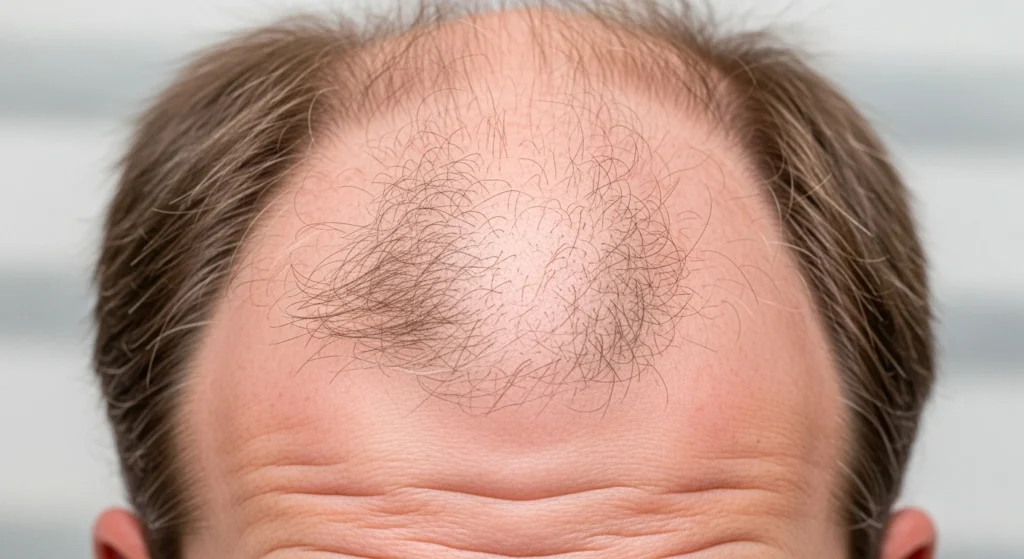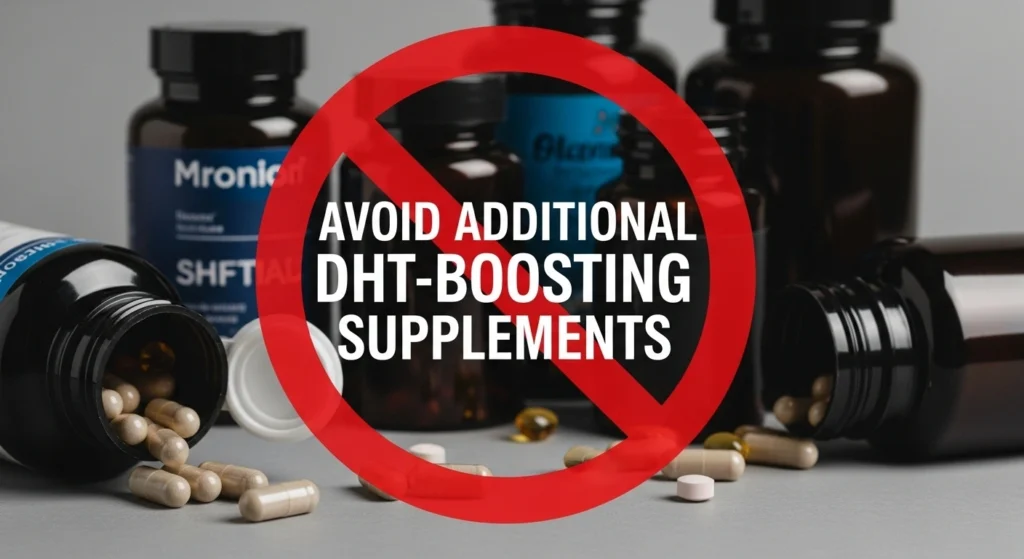Summary
How to Stop Hair Loss After a Steroid Cycle? Hair loss after a steroid cycle is common but treatable. By discontinuing steroid use, consulting a healthcare professional, and using treatments like finasteride, minoxidil, and PRP therapy, you can prevent further hair loss and promote regrowth.
Additionally, maintaining a healthy diet, managing stress, and following expert recovery tips can support the recovery process. For the best results, seek personalised advice from a specialist.
Introduction
Hair loss after a steroid cycle is a common concern among athletes and bodybuilders. If you’re experiencing this issue, you’re not alone. The good news is that there are effective ways to stop hair loss and restore your hair’s health.
In this article, we’ll explore the causes of steroid-induced hair loss and the best strategies to prevent and treat it. By following these methods, you can regain healthy hair and boost your confidence once again.
Understanding Steroid-Induced Hair Loss

What Is Steroid-Induced Hair Loss?
Steroid-induced hair loss, also known as anabolic steroid-induced alopecia, occurs when the use of anabolic steroids increases levels of dihydrotestosterone (DHT). DHT is a hormone that shrinks hair follicles, leading to hair thinning and eventual hair loss. This condition is more common in those who are genetically predisposed to androgenic alopecia, a type of hair loss.
Why Some Individuals Are More Susceptible
Not everyone who uses steroids will experience hair loss. Genetics play a significant role in whether or not someone is susceptible. If you have a family history of male or female pattern baldness, you may be at a higher risk. People with a sensitivity to DHT are also more likely to experience hair thinning during and after steroid use.
Timeline of Hair Loss After Steroid Use
Hair loss typically begins within a few months after starting a steroid cycle. However, the rate of hair loss and recovery can vary from person to person. Most people experience shedding shortly after stopping steroids, with hair regrowth often taking several months.
Immediate Steps to Mitigate Hair Loss
Discontinuing Steroid Use
The first step in stopping hair loss after a steroid cycle is to discontinue steroid use. Stopping steroids allows your body to begin regulating hormone levels naturally, reducing the DHT that’s causing hair follicle miniaturisation.
Consulting a Healthcare Professional
It’s essential to consult a dermatologist or endocrinologist if you’re concerned about hair loss. A healthcare provider can help determine the best course of action based on your individual situation. They may recommend blood tests to check your hormone levels and guide you through potential treatments.
Medical Treatments to Combat Hair Loss
Finasteride (Propecia)
Finasteride, commonly known by the brand name Propecia, is a 5-alpha reductase inhibitor that reduces DHT production. By blocking the conversion of testosterone to DHT, finasteride helps prevent further hair loss and promotes hair regrowth in some users. Studies show that finasteride can be particularly effective in cases of steroid-induced hair loss. [Medical Reviewer Note Needed Here: Refer to studies on finasteride and DHT reduction.]
Minoxidil (Rogaine)
Minoxidil is an over-the-counter topical solution used to stimulate hair growth. It works by increasing blood flow to the hair follicles, providing them with the nutrients they need to grow. Minoxidil is an effective solution for regrowing hair and is often recommended alongside other treatments like finasteride.
Platelet-Rich Plasma (PRP) Therapy
PRP therapy involves using your own blood to extract platelets, which are then injected into the scalp to stimulate hair regrowth. PRP has shown promising results in treating various forms of hair loss, including steroid-induced alopecia. The procedure is minimally invasive and can be done in-office with little downtime.

Natural and Lifestyle Interventions
Nutritional Support
Proper nutrition plays a crucial role in hair health. Ensure you’re getting enough vitamins and minerals that promote healthy hair, such as biotin, zinc, and vitamin D. Including these nutrients in your diet may support the regrowth process and prevent further damage.
Stress Management
Stress can exacerbate hair loss, so it’s essential to manage stress levels. Engage in activities like meditation, yoga, or regular exercise to reduce stress. Lowering stress hormones can have a positive effect on hair regrowth.
Gentle Hair Care Practices
Avoid harsh chemical treatments and tight hairstyles that can pull on your hair and cause damage. Use a gentle shampoo and conditioner, and minimise heat styling to keep your hair healthy and strong during the recovery process.
Recovery Timeline and Expectations
Short-Term Recovery (1–3 Months)
In the first 1 to 3 months after discontinuing steroids, you may experience continued hair shedding. This is part of the natural hair cycle, and it’s essential to be patient. Hair follicles will begin to stabilise, and new growth may start to appear.
Mid-Term Recovery (3–6 Months)
By 3 to 6 months, early signs of regrowth should be visible if you’ve been using treatments like finasteride or minoxidil. It’s important to stay consistent with your treatments and avoid any further DHT exposure to maximise your results.
Long-Term Recovery (6–12 Months)
Full recovery can take up to a year. During this period, most users can expect noticeable improvements in hair density and quality. However, it’s important to remember that results vary depending on genetics and treatment adherence.
When to Seek Professional Help
Persistent Hair Loss
If hair loss continues beyond 6 months despite treatment, it’s time to consult with a professional. Persistent shedding could indicate that the underlying cause of hair loss needs to be addressed further.
Severe Scalp Conditions
If you notice inflammation, itching, or scarring on your scalp, it’s important to seek immediate medical attention. These symptoms could indicate an underlying condition like scarring alopecia or folliculitis that requires specialised care.
Psychological Impact
Hair loss can take a toll on your self-esteem and mental health. If you’re feeling distressed or struggling emotionally, consider speaking to a therapist or counsellor who can help you navigate the emotional aspects of hair loss.
Expert Recovery Tips
Monitor Hormone Levels
Regularly monitoring your hormone levels can help you understand how your body is reacting post-cycle. This can provide valuable insights into your recovery process and guide your treatment plan.
Avoid Additional DHT-Boosting Supplements
Be cautious about using any supplements that may increase DHT levels, such as testosterone boosters or prohormones. Stick to treatments that have been proven to block DHT, like finasteride.

Maintain a Healthy Scalp Environment
Keep your scalp clean and well-moisturised. Regular scalp massages can improve blood circulation and promote healthy hair growth. Using mild shampoos and avoiding harsh chemicals will also help preserve your hair’s health.
FAQs
Can Hair Loss from Steroids Be Permanent?
In most cases, hair loss from steroids is not permanent. With proper treatment, many people experience full or partial regrowth. However, it’s important to address the issue as soon as possible to improve your chances of regrowth.
Is It Safe to Use Finasteride During a Steroid Cycle?
Using finasteride during a steroid cycle can help prevent further hair loss by blocking DHT. However, it’s crucial to consult with a healthcare provider before starting any new medication.
How Long Should I Wait Before Starting Hair Loss Treatments After a Steroid Cycle?
It’s advisable to begin treatments as soon as you notice hair loss. The earlier you start, the better the chances of regrowing your hair and minimising long-term damage.
Next Step
If you’re dealing with hair loss after a steroid cycle, it’s crucial to take action sooner rather than later. Consult with a healthcare professional to create a personalised recovery plan and get back to feeling your best. Book a consultation with Dr Rana Irfan in Islamabad today to ensure a smooth and successful recovery after your hair transplant.
